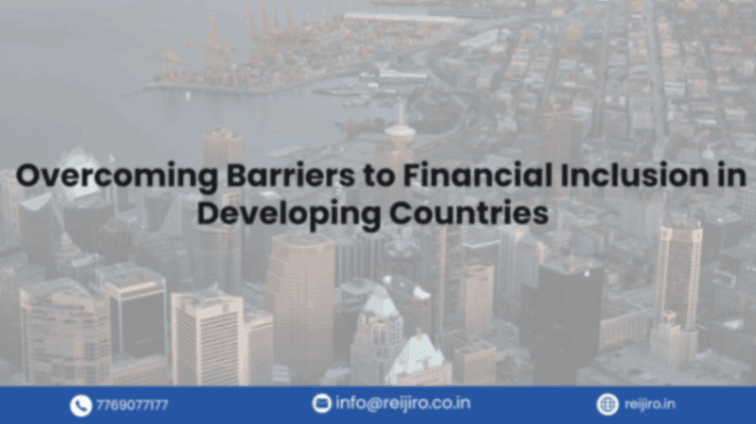Overcoming Barriers to Financial Inclusion in Developing Countries
Financial inclusion, the access and usage of affordable financial services by individuals and businesses, is a crucial element in promoting economic growth, reducing poverty, and achieving sustainable development. However, in many developing countries, significant barriers hinder the widespread adoption of formal financial services, leaving a substantial portion of the population excluded from the benefits of financial inclusion. In this comprehensive blog, we will delve into the barriers that impede financial inclusion, the social and economic impact of exclusion, strategies to overcome these obstacles, and the role of technology in driving inclusive financial ecosystems.
Understanding Financial Inclusion and Its Importance
Financial inclusion goes beyond basic access to banking services; it encompasses a wide range of financial products and services, including savings accounts, credit, insurance, payments, and investments. Access to these services empowers individuals and businesses to manage risks, invest in education, healthcare, and business ventures, and achieve greater financial stability. Ultimately, financial inclusion plays a pivotal role in breaking the cycle of poverty and driving sustainable development.
Barriers to Financial Inclusion in Developing Countries
1. Lack of Access to Formal Banking Services:
Barrier: Many individuals in developing countries, particularly in rural and remote areas, lack access to physical bank branches due to geographical constraints and limited infrastructure.
2. Low Levels of Financial Literacy:
Barrier: A lack of understanding about financial products and services prevents individuals from making informed decisions and utilizing available opportunities.
3. Informal Economy Dominance:
Barrier: In developing countries, a significant portion of economic activities occurs in the informal sector, where transactions are conducted in cash and remain outside the formal financial system.
4. Limited Identification Documents:
Barrier: A significant number of people lack formal identification documents required for opening bank accounts and accessing financial services.
5. High Costs of Financial Services:
Barrier: Traditional financial services can be expensive, with high transaction fees and account maintenance charges that deter low-income individuals from using formal channels.
6. Lack of Trust in Formal Institutions:
Barrier: Historical distrust in formal financial institutions, often rooted in past experiences of fraud or discrimination, can discourage people from using formal banking services.
7. Gender Disparities:
Barrier: Women in developing countries often face additional barriers to financial inclusion due to cultural norms, limited mobility, and restricted access to resources.
8. Insufficient Infrastructure:
Barrier: Poor technology infrastructure, including limited internet connectivity and lack of electricity, hampers the adoption of digital financial services.
Impact of Financial Exclusion
The consequences of financial exclusion are far-reaching and impact both individuals and societies as a whole. Financially excluded individuals lack the means to effectively manage risks, save for the future, and access credit for investment. This perpetuates cycles of poverty and restricts opportunities for socio-economic mobility. On a broader scale, financial exclusion hinders economic growth, limits human capital development, and reduces the effectiveness of social safety nets.
Strategies for Overcoming Barriers to Financial Inclusion
1. Digital Financial Services:
Digital financial services, including mobile banking and digital wallets, have revolutionized financial inclusion by providing convenient, affordable, and accessible ways for individuals to conduct financial transactions.
2. Financial Education and Literacy Programs:
Investing in financial education initiatives can empower individuals with the knowledge and skills required to make informed financial decisions, manage their money, and access suitable financial products.
3. Simplified Account Opening Processes:
Simplifying the account opening process, reducing documentation requirements, and allowing digital identity verification can increase access to formal financial services.
4. Mobile Money Agents and Banking Correspondents:
Utilizing local agents or banking correspondents can bring financial services closer to remote communities, reducing the need for individuals to travel long distances to access banks.
5. Credit Scoring and Risk Assessment:
Leveraging alternative data sources and innovative credit scoring models can enable financial institutions to assess creditworthiness of individuals with limited credit histories.
6. Partnerships and Collaboration:
Public-private partnerships and collaborations between financial institutions, governments, NGOs, and technology companies can pool resources to develop tailored solutions for financial inclusion.
7. Gender-Inclusive Strategies:
Implementing gender-specific strategies that address the unique challenges faced by women in accessing financial services can help bridge the gender gap in financial inclusion.
8. Regulatory Reforms:
Governments can enact regulatory reforms that encourage innovation, lower transaction costs, and create an enabling environment for digital financial services to thrive.
Role of Technology in Driving Inclusive Financial Ecosystems
Technology, particularly mobile phones and digital platforms, has been a game-changer in advancing financial inclusion in developing countries. Here’s how technology is reshaping the financial landscape:
1. Mobile Banking and Digital Wallets:
Mobile banking and digital wallets provide individuals with a secure, convenient, and cost-effective way to access financial services without the need for physical bank branches.
2. Digital Payments:
Digital payment solutions, including mobile money, allow individuals to make transactions, pay bills, and transfer money using their mobile phones.
3. Biometric Identification:
Biometric technology enables individuals to establish digital identities using fingerprints or facial recognition, overcoming the barriers posed by lack of formal identification documents.
4. Blockchain and Cryptocurrencies:
Blockchain technology and cryptocurrencies can provide secure and transparent ways to conduct financial transactions, especially in areas with weak traditional banking infrastructure.
5. Data Analytics and AI:
Data analytics and artificial intelligence can be used to assess creditworthiness, personalize financial services, and analyze financial behaviors to offer tailored solutions.
Conclusion
Overcoming barriers to financial inclusion in developing countries is an imperative for achieving sustainable economic growth and poverty reduction. By addressing challenges such as limited access, low financial literacy, and insufficient infrastructure, governments,



